Cornstarch is a common household staple, and you’ll find a box or bottle of the white powder in most kitchens. It’s typically used as a thickening agent, tossed into everything from marinades to casseroles. However, in addition to turning watery broths into hearty stews, cornstarch actually has a number of household uses, particularly in the garden. You can give the pantry staple several more jobs in the home, making it a workhorse item.
It’s well known that it can come in handy as a multipurpose household cleaner, and has been used in various other innovative hacks, from a DIY deodorant to a dog coat detangler. However, this starchy substance is also a handy friend for anyone with a green thumb. From keeping your soil in tip-top condition to keeping pests at bay, fertilizing your lawn, and helping your plants retain moisture, cornstarch covers a lot of bases. Let’s dig deep and find out how cornstarch can transform your garden in many beneficial and unexpected ways.
It keeps your soil healthy
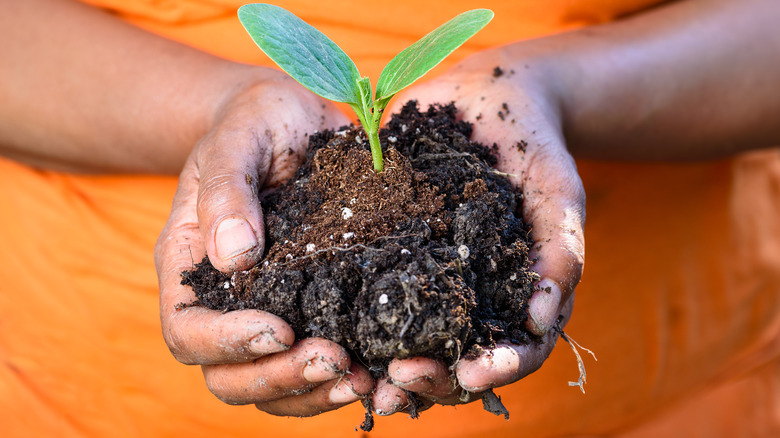
As anyone who has planted a potato or reared a rose knows, healthy soil is the building block for everything that grows in your garden. Without it, you might as well put down your tools and give up, because you’re fighting a losing battle. Fortunately, if your soil is suffering and deficient in the nutrients it needs to flourish, a little cornstarch can be just the ticket. Rich in magnesium, calcium, potassium, and phosphorous, cornstarch can help feed your soil with the goodness it needs to stay healthy.
In a report by the International Journal of Environmental Research and Public Health, researchers found that when the antimicrobial membranes found in cornstarch biodegraded in the soil, they helped maintain its pH levels at ideal conditions for growing plants. Additionally, they boosted the number of microorganisms in the earth — which help plants grow strong and healthy — and helped the soil retain water more efficiently. For best results, sprinkle a little cornstarch into your soil above the roots of your plants and then lightly water.
It can be used as a fertilizer
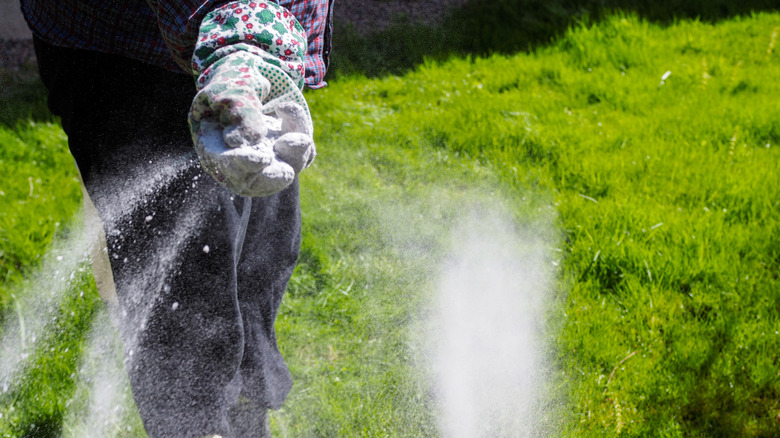
As well as improving the texture of our food, cornstarch can also be used to help grow it. The corn extract in the powder helps release nutrients in your soil that encourage healthy and effective plant growth. Sustainable packing peanuts have often been used as a fertilizer for their cornstarch content. This process involves dissolving the peanuts in warm water and watering the plants with that liquid. However, you can simply stir up some cornstarch powder in a watering can and use it that way.
A report in HortScience found that tomato plants treated with cornstarch-based, biodegradable polymer had more flowers and fruit than those grown without. Additionally, because it is high in nitrogen, the powder can be used to fertilize your grass and keep it looking healthy and green. For best results, use 10 pounds of cornstarch for every 1,000 square feet of lawn you have, and water. This might not be the most budget-friendly recommendation if you have a large property, but it will work great for standard-size yards.
It can help combat nitrogen pollution

maxbelchenko/Shutterstock
A little nitrogen in your soil is great. It helps provide plants with the energy they need to grow, and life as we know it wouldn’t be possible without it. However, you can have too much of a good thing, and when the nitrogen levels in your soil get a little too excessive, you’ve got big trouble on your hands. Fortunately, cornstarch can help combat the nitrogen pollution caused by synthetic fertilizers. When there’s a build-up of nitrogen in your soil, it gives your fast-growing plants an advantage at the expense of your slow growers. This leads to overcrowded garden beds and unhealthy plants.
Additionally, too much unused nitrogen in your soil can end up as a pollutant that can easily contaminate water run-off. A 2009 study by NC State University found that after coating a popular garden fertilizer with a slurry made of cornstarch, the soil absorbed the nitrogen from the fertilizer in a slower and more manageable manner. So if you use fertilizers, a cornstarch coating could be all you need to stop the nitrogen levels from getting out of hand.
It deters worms
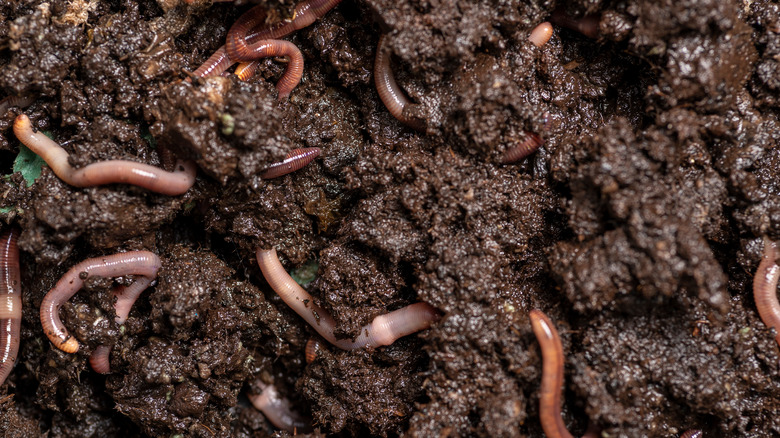
photoste/Shutterstock
There’s nothing like waking up and finding that the crop of carrots you have been cultivating for months is being slowly eaten by a horde of hungry worms. Although worms help fertilize your soil by excreting phosphorous and potassium, they can also fall into the category of annoying pests when they start feeding on the plants in your garden. To get on top of your worm trouble, try sprinkling a little cornstarch on your plant’s leaves to prevent these slithering vandals and other pests from ruining the integrity of your special place.
The dust of cornstarch suffocates the worms and makes your plants a lot less attractive to other pests. Another approach that works is to mix cornstarch with a bit of water and garlic essential oil and spray it near your plants to deter pests. In fact, corn starch has such great pest control properties that the U.S. Department of Agriculture Agricultural Research Service has developed products using it to fight mosquitos. Tony Banks, senior assistant director of agriculture, development, and innovation for Virginia Farm Bureau Federation, explained to News Journal, “As an insecticide, this type of product could be environmentally safer and pose fewer exposure risks. Naturally, this technology could lead to greater demand for corn as more starch-based products are developed.”
It helps your seeds flourish
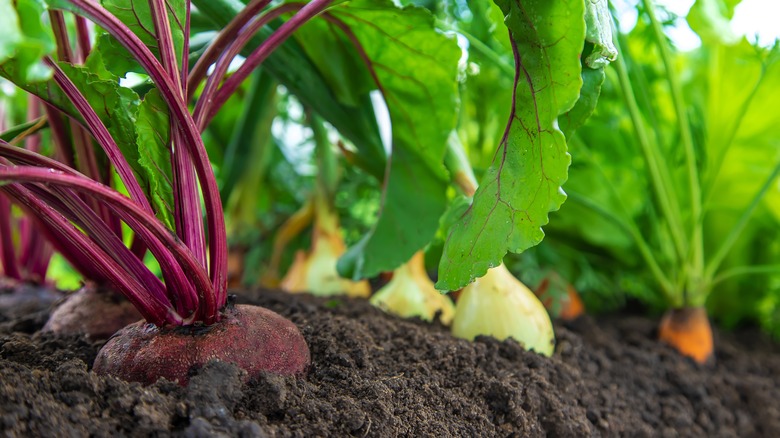
Tatevosian Yana/Shutterstock
When you sow tiny seeds, it’s only natural to expect big outcomes. Yet things don’t always go to plan, and what was put in the ground often stays there with no prize-winning plants to show for all your hard work and endeavor. Spacing seeds and not sowing them too thickly is a major part of the struggle. Instead of being sown, some seeds often go astray and end up floundering. Particularly when it comes to parsley, carrots, basil, lettuce, amaranth, and begonias. To get the job done right, you could make a DIY seed tape, or you could make a cornstarch-based seeding gel.
Mix 1 tablespoon of cornstarch with 1 cup of water, pour into a saucepan, and bring it to a boil. Once the mixture has cooled, skim off the skin on the surface and place the gel into a plastic bag that zips closed. Pour a small amount of seeds into the bag and distribute them evenly. Remove any excess air, and zip it shut. Then, cut a small triangle in the bag and slowly squeeze the gel along your planting rows. Cover with soil and water well. The gel will dissolve, and no seed will be left scattered on barren land. Result!
It can help treat powdery mildew
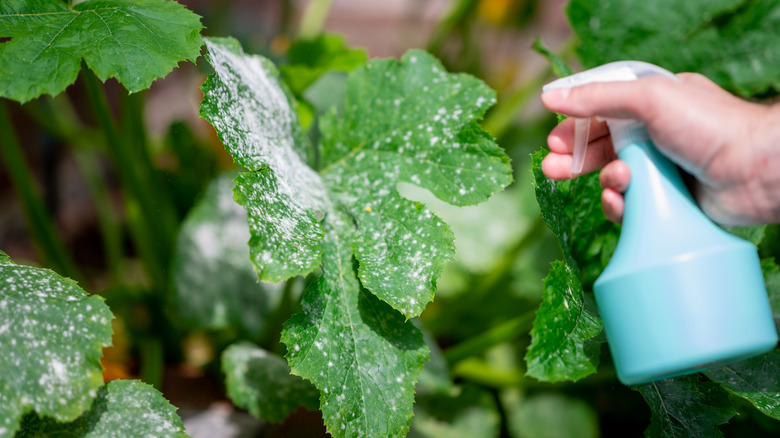
Fokusiert/Getty Images
To a gardener, spotting powdery mildew on plants is a bit like that creeping sense of dread that you get when you spot the first signs of mold on your bathroom ceiling. It’s unsightly, unnerving, and a warning of the horror to come if direct action is not taken. Fortunately, if your plants look like they’ve just decided to go crazy with what looks like talcum powder, you probably have the tool to combat it in your kitchen cupboard — cornstarch!
Although powdery mildew does not pose a mortal threat to your plants, it can cause them a great deal of stress. The powdery and white covering on their leaves prevents them from absorbing sunlight and makes the process of photosynthesis that much harder. For best results, add 1 tablespoon of cornstarch to 1 gallon of water. Add another 1/2 teaspoon of dish soap and spray liberally on the leaves and stems of your plants in your garden once a day until the problem is solved. This solution should act as both a preventive and a cure.
It helps minimize water usage
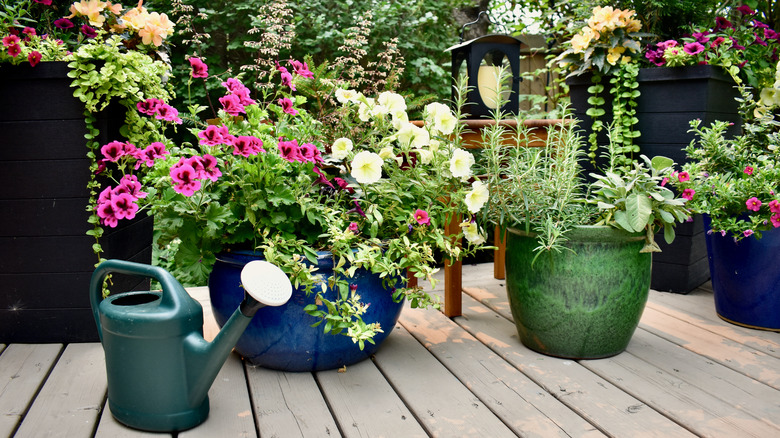
Klem Mitch/Shutterstock
Although when it falls from the skies, cascades in waterfalls, and rolls in waves, it is still a limited resource. Water usage is something we should all bear in mind when gardening and help play our part in minimizing it. Potted plants require a lot of water, especially during the summer, but adding a little cornstarch to the containers can help lock in moisture and reduce their thirst.
It’s usually advised to add 2 tablespoons of cornstarch to a 1-gallon pot, and 1/4 cup of cornstarch to a 5-gallon pot. As a thickening agent, the cornstarch naturally absorbs water, and when added to your planters, it helps your plants retain it. And the best part is you only have to do this once a season! Not only will your plants require fewer visits with the hose or watering can, but you are also doing your bit for the environment.
It can be used against an ant infestation
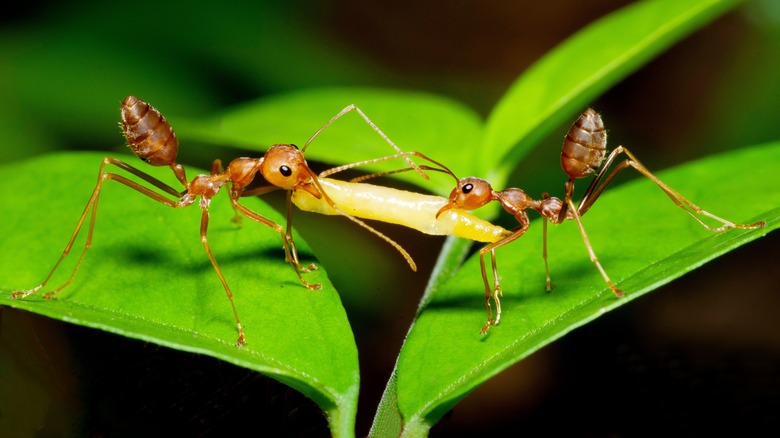
Adisak Mitrprayoon/Getty Images
As insect predators and pollinators, ants are integral to the biodiversity of a healthy garden. However, when you have an infestation of ants nesting at the roots of your plants, it can make them more susceptible to diseases as well as stunt growth. As ants also eat the honeydew produced by aphids, they have a vested interest in keeping the aphids alive and will often protect them from ladybirds and other predators. As an unchecked aphid population is capable of draining your plants clean of juice, an ant infestation is not an ideal situation for your garden. Fortunately, help is at hand in the shape of cornstarch.
Identify the areas where you have noticed a lot of ant activity and liberally sprinkle the cornstarch on the hot spots. Once you see the army of ants carrying out their usual business and picking up the cornstarch as a potential food source, it’s time to pull out the spray gun. Lightly wet the cornstarch, forming a thick paste that will stop the ants in their tracks.
It can beat the blisters
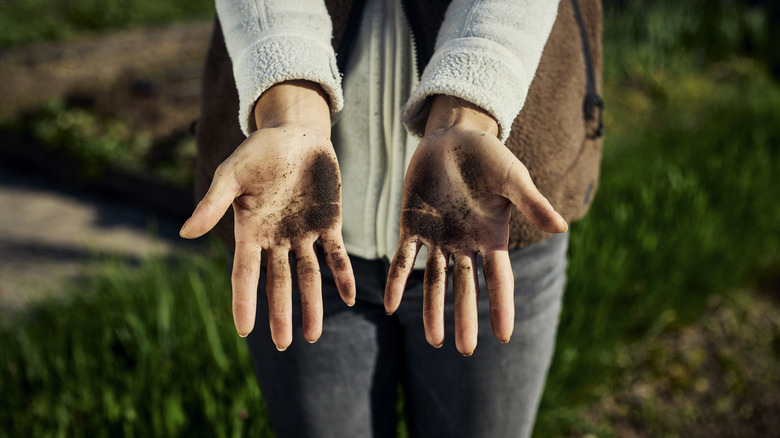
Pixdeluxe/Getty Images
As anyone who has spent any amount of time digging, raking, sowing, growing, cutting, and generally getting their hands dirty knows, gardening attracts blisters. Sweaty hands fiercely gripping shovels, hoes, shears, trowels, hedge-cutters, and a host of implements is a recipe for disaster when it comes to your hands. While blisters might be a fact of life, it’s pointless to suffer in silence when a little cornstarch can relieve your woe.
Cornstarch doesn’t combat blisters after the fact, but it works well as a preventative. Simply sprinkle a little of the white powder on your hands before you put on your gardening gloves. All that sweat and friction should be nullified before it gives birth to a sore. This hack also works well on keeping your feet smooth and dry. Simply give your feet a light covering before you pull on your socks and shoes, and you’re good to go. With no debilitating blisters to worry about, you’re free to put in the hard hours that can help transform your garden.
It can improve the grip on your garden tools
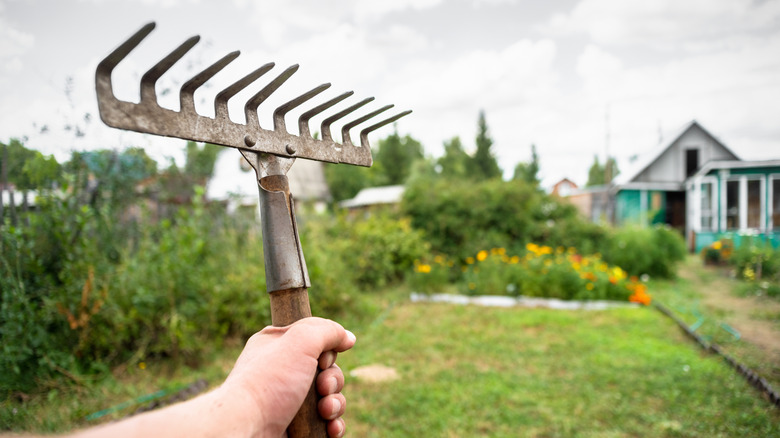
Happynati/Getty Images
As well as preventing blisters, cornstarch can also help you get a grip on your garden tools. And as all keen gardeners know, a solid grip is everything when you’re busy hacking, cutting, slashing, streaming, trimming, pruning, and mowing. Not only does it get the job done properly and get the most out of your tools, but it also helps keep you safe. If you lose your grip on a hedge trimmer while attacking an unsightly bush, you’re going to know about it.
To avoid accidents and maximize the productivity of every task, the last thing you need is sweaty hands undermining you when it matters most. To keep a firm grip in the heat of even the most arduous garden task, simply give the handles of your gardening tool a light covering of cornstarch before you begin. Its capacity to absorb moisture will ensure nothing escapes your grip.
It cleans up greasy stains
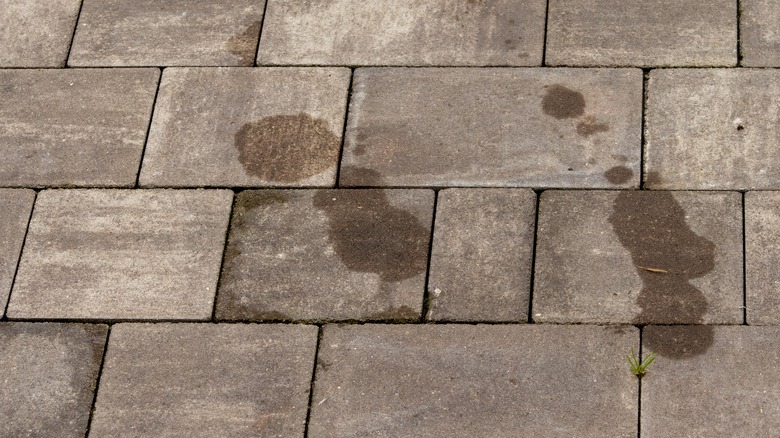
daily_creativity/Shutterstock
A deck or patio in a state of neglect and disarray can easily detract from any garden’s lushness and eye-catching dynamic. Alongside overflowing trash cans, rusty bikes, and abandoned tools, greasy stains and spills are a big no-go. Oil has a habit of getting everywhere, but when left to sit on concrete, tarmac, cobbles, stone, or slabs, its stain will spread and become a huge eyesore. It’s something you need to take care of and fast, and cornstarch may well be the answer.
To remove any offensive oil or greasy patches from the vicinity of your garden, sprinkle a healthy amount of cornstarch onto the stain. After waiting a few hours for the white powder to absorb the grease and work its magic, you should be able to sweep away the cornstarch along with the stain. You’ll be able to breathe deep and relax once again in a blemish-free environment.
It can give your rubber gloves a new lease on life
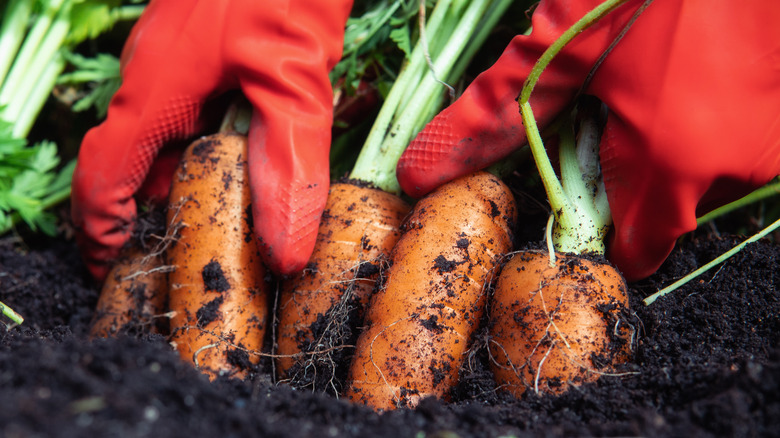
sonicbox/Shutterstock
Much like rubber boots, rubber gloves are one of life’s essentials that often get overlooked because they’re 100% function and zero fashion. Yet where would we be without these lurid, heavy-duty, and long-cuffed gloves to protect the smoothness of our skin when washing dishes, cleaning the toilet, removing the rubbish, and indulging in general garden tasks? Let’s be honest: Our rubber gloves take a daily bashing, but if you want to give them a new lease on life, try a little cornstarch.
The magic white powder not only stops dampness from setting in, but makes them a lot easier to put on and take off. After a fair few uses, getting your hands in and out of a pair of rubber gloves can be akin to forcing a fat sausage into a tight skin. However, sprinkling a little cornstarch into each glove now and then will keep them loose and lovely. It’ll also eliminate any nasty odors that refuse to shift, leaving you to garden in peace.
It can soothe sunburn
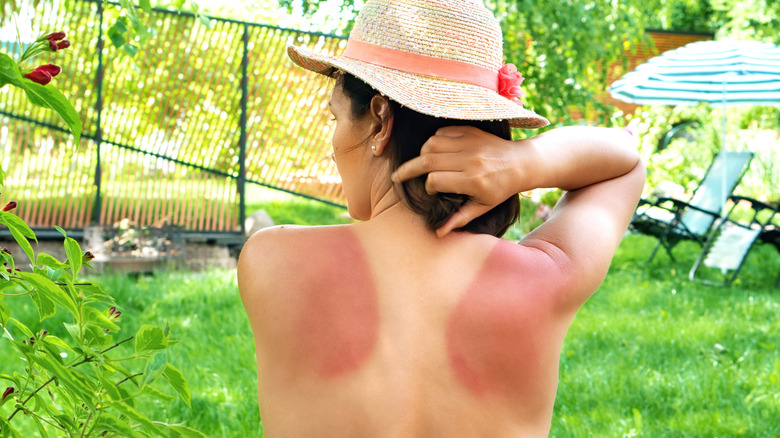
Irina Nazarova/Getty Images
Summer is the perfect season for getting out in the garden and getting things done. However, all that toil when the sun is high and the skies are blue can wreak havoc on your skin. Every now and then, even the most cautious among us forget their sunscreen, hat, and long sleeves when venturing outside to get our hands dirty in the garden. Yet when you feel boiled alive and are busy regretting your recklessness, fear not, for a little cornstarch can help alleviate your sunburn and make you feel better in no time.
You can mix up a little cornstarch with some water to form a paste that you can then gently rub into the area of your body that the sun hit hardest. Alternatively, you can also sprinkle it on your skin to create a barrier between you and fabrics, relieving the burn where they may touch.
It relives bug bites
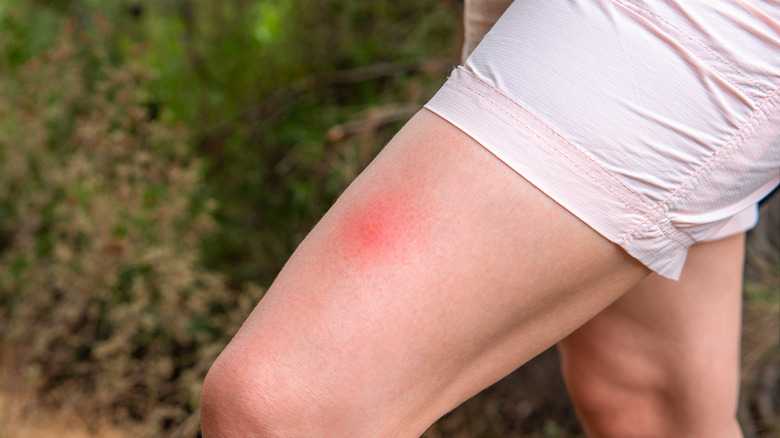
CeltStudio/Shutterstock
Gardening is the perfect way to connect with the great outdoors. Getting out in the elements, knee-deep in greenery, and up to your elbows in the soil is fundamentally good for the soul. The downside of all that is sooner or later you’ll get bitten by a fair few bugs. As organic material, you’re fair game to a richly diverse amount of insects who view your flesh as a sweet treat. Although getting bitten can be a sore point, there is relief out there, and some of it goes by the name of cornstarch.
When some insect has decided you’re nothing more than a free lunch and you need to take the sting out of a bite, take 3 tablespoons of cornstarch and mix it up with 1 tablespoon of cold water. Stir until you have a paste, and then gently apply it to the site of the bite. As it dries, you should feel the sweet relief wash over you. For best results, leave it on overnight, and wake up refreshed for another bout of gardening.
It can help soothe rashes

Andrey_Popov/Shutterstock
Gardening is all about throwing caution to the wind and getting dirty. However, when you’re losing yourself in the sheer joy of giving nature a helping hand, it’s easy to forget there are a lot of plants that can give you a nasty rash — and we’re not just talking poison ivy! Stinging nettle, wood nettle, the weirdly named baby’s breath, leadwort, ragweed, giant hogweed, and poison oak are just a few of the plants that can pop up in a garden and act as a serious irritant that can give you a nasty rash.
Yet when your skin is inflamed and is itching and burning, a little cornstarch can be your friend. Loaded with vitamins and minerals such as iron and magnesium, cornstarch can help regenerate your skin cells and keep them healthy. However, it’s the high zinc levels that help to soothe rashes and relieve redness and inflammation. It also helps absorb the sweat that can aggravate rashes, and its fine powdery substance does not block pores but keeps your skin dry and clean. To make the paste, mix 1 teaspoon corn starch with equal parts baking soda and apply to the area as needed. Once the rash calms, it’s time to grab your garden shears and carry on where you left off.



